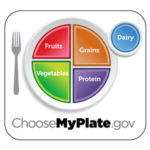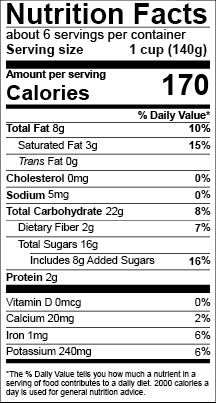
Understanding the nutritional content of a meal is important. To help determine the nutritional content of your meals, most foods, with the exception of fruits, vegetables and some prepared foods, have a Nutrition Facts label as a tool to help you figure out what you are eating and an appropriate amount for you. While nutrition facts labels have useful information, oftentimes people eat differently than what the label reflects.
What is a “serving size” versus a “portion”?
A serving size generally refers to the information on the nutrition facts label. A serving size is determined using guidelines published by the FDA (the Food and Drug Administration). Serving sizes are intended to help a consumer figure out about how much of a food is “typically” eaten at one time and also to provide a reference point for all of the data provided in the Nutrition Facts label.
In contrast to a serving size, a portion is the true amount one puts on his or her plate. A portion may be more or less than a serving size. Portions are generally how people talk about the amount of food they eat. Someone’s portion can vary depending on their age, stage of development, hormones, gender, activity level, hunger level, and many other factors.
Why does serving size matter?
Serving size matters if you are trying to understand the nutritional makeup of a food using the Nutrition Facts label. These quantities are often based on the “usual” amount of a food that a person would consume; for example the serving size of yogurt is 1 cup whereas the serving size of sour cream is 2 tablespoons. When looking at a Nutrition Facts label, all of the information is based on the serving size. For example, in the sample Nutrition Facts label shown here, the serving size is 1 cup, and there are 6 servings (6 cups) in the entire container. If you ate twice that amount, you would need to multiply all of the lines on the label to reflect the nutritional information in the amount you ate. So, for example, in 2 cups of this food, which is 2 servings, there would be 16 grams of fat and 4 grams of protein.

Additionally, understanding how to use the Nutrition Facts label can help you figure out if you are getting enough of the nutrients that your body needs.
Is a serving size the amount I’m supposed to eat?
No! Not necessarily. A serving size is simply the amount determined by the FDA as the amount “generally consumed” in order to list the nutrient data for one serving. The FDA doesn’t know if you just had a snack and only want a taste of another food or if you are really hungry and need to fuel up. For example, the serving size for bread is one slice. Sometimes this might be the amount of bread you eat if you were having for example, a piece of toast with eggs. Other times, you might have a sandwich made with two slices of bread.
Why do portion sizes matter?
Understanding what an appropriate portion is of certain foods may help you to make sure you are eating about the right amount. For example, it is important for a person to eat a proper portion of vegetables rather than just one bite in order to get the important vitamins and minerals that come from these foods. Sometimes it can be challenging to eat the right amount that your body needs, such as at restaurants where meals are pre-portioned (served in a specific amount) or at parties where you might “graze” and eat snack foods over a longer period of time. In these cases, having an idea of what a portion of particular foods look like may help you to ensure that you eat the right amount for you.
How can I estimate appropriate portions without measuring?
There are many ways that people can estimate, or “eyeball,” an amount of food to make sure it is about the right amount for them. One idea for how to do this is by using the “MyPlate” method of eating. This is how many dietitians teach people about food. In this meal pattern, the plate is divided into three sections. One half of the plate is for fruits and vegetables, one quarter of the plate is for protein and the final quarter of the plate is for a source of whole grain. This helps ensure balance in what we eat so that our bodies can get all of the important nutrients that we need.
How do I know if I’m eating the right portions for me?
It’s always a good idea to talk with your health care provider or a registered dietitian to make sure you are eating the right amounts of a variety of foods that are best for your stage of growth, activity level, and hunger and fullness cues.
 Young Men's Health
Young Men's Health
